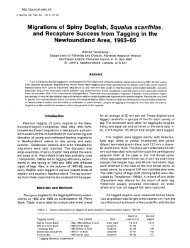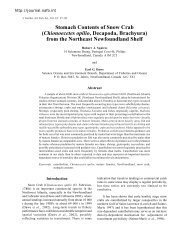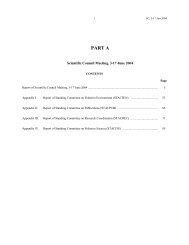Key to Genera and Species of Decapod Larvae Present in Ungava ...
Key to Genera and Species of Decapod Larvae Present in Ungava ...
Key to Genera and Species of Decapod Larvae Present in Ungava ...
Create successful ePaper yourself
Turn your PDF publications into a flip-book with our unique Google optimized e-Paper software.
SQUIRES: <strong>Decapod</strong> Crustacean <strong>Larvae</strong> from <strong>Ungava</strong> Bay21<strong>Key</strong> <strong>to</strong> <strong>Genera</strong> <strong>and</strong> <strong>Species</strong> <strong>of</strong> <strong>Decapod</strong> <strong>Larvae</strong><strong>Present</strong> <strong>in</strong> <strong>Ungava</strong> Bay(From observations <strong>and</strong> various authors. Tables 4–12)<strong>Larvae</strong> <strong>of</strong> species shown <strong>in</strong> parentheses not taken <strong>in</strong> <strong>Ungava</strong> Bay1. Carapace somewhat globular <strong>and</strong> with large sp<strong>in</strong>es, abdomen slender, curvedbackward ....................................................................................................................... 2– Carapace <strong>and</strong> abdomen elongate, shrimp-like ......................................................... 52. Telson forked <strong>and</strong> without uropods; carapace with long rostral, posterior dorsal<strong>and</strong> lateral sp<strong>in</strong>es .................................................... Hyas ............................................. 3– Telson truncate <strong>and</strong> with uropods <strong>in</strong> later stages; carapace with only a longrostral sp<strong>in</strong>e ..................................................Pagurus ........................................... 43. Zoea with about one-third <strong>of</strong> dorsal <strong>and</strong> rostral sp<strong>in</strong>es covered withm<strong>in</strong>ute sp<strong>in</strong>ules shorter than the width <strong>of</strong> the sp<strong>in</strong>e where attached ........... (Hyas araneus)– Zoea with about one-third <strong>of</strong> dorsal <strong>and</strong> rostral sp<strong>in</strong>es coveredwith s<strong>to</strong>ut sp<strong>in</strong>ules longer than the width <strong>of</strong> the sp<strong>in</strong>e whereattached ................................................................................................Hyas coarctatus4. Antennal flagellum styliform ................................................................ (Pagurus acadianus)– Antennal flagellum bifid ................................................................ Pagurus pubescens5. Abdomen with a dorsolateral sp<strong>in</strong>e on somites 4 <strong>and</strong> 5 or on somite 5 only ............... 7, 8– Abdomen without dorsolateral sp<strong>in</strong>e on any somite .. P<strong>and</strong>alus ................................ 66. Stages I <strong>and</strong> II Zoea about 6–7 mm <strong>in</strong> <strong>to</strong>tal length; Stages II <strong>and</strong>III with many setae on antennal scale <strong>and</strong> scaphognathite .................... P<strong>and</strong>alus borealis– Stages I <strong>and</strong> II Zoea about 4–5 mm <strong>in</strong> <strong>to</strong>tal length; Stages II<strong>and</strong> III with few setae on antennal scale <strong>and</strong> scaphognathite ......... P<strong>and</strong>alus montagui7. Dorsolateral sp<strong>in</strong>e on abdom<strong>in</strong>al somite 5 only (not <strong>in</strong> <strong>Ungava</strong> Bay)– Denticles on abdom<strong>in</strong>al somites 4 <strong>and</strong> 5 ................................. (P<strong>and</strong>alus prop<strong>in</strong>quus)– Denticles on abdom<strong>in</strong>al somites 3 <strong>and</strong> 4 ....................................... (Dichelop<strong>and</strong>alus)8. Exopods on some <strong>of</strong> the pereopods ................................................................................ 9– No exopods on pereopods ........................................................................................ 139. Exopods on first <strong>to</strong> third or first <strong>and</strong> second pereopods– Exopods on first <strong>to</strong> third pereopods ........................ Eualus....................................... 10
22J. Northw. Atl. Fish. Sci., Vol. 15, 1993– Exopods on first <strong>and</strong> second pereopods ................ Spiron<strong>to</strong>caris ..................... 1210. Total length <strong>of</strong> Stage I Zoea about 5 mm ...................................................................... 11– Dorsolateral sp<strong>in</strong>es on abdom<strong>in</strong>al somites 4 <strong>and</strong> 5 ................................ Eualus fabricii– Dorsolateral sp<strong>in</strong>es on abdom<strong>in</strong>al somite 5 only .............................. Eualus gaimardi11. Total length <strong>of</strong> Stage I Zoea 3 mm or less– Total length <strong>of</strong> Stage I Zoea 3 mm; sp<strong>in</strong>es on telson 7+7 .............. (Eualus macilentus)– Total length <strong>of</strong> Stage I Zoea 2 mm; sp<strong>in</strong>es on telson 6+6 ................ (Eualus pusiolus)12. Exopods on first <strong>and</strong> second pereopods only ............. Spiron<strong>to</strong>caris .......................– Stages I <strong>and</strong> II Zoea about 6–7 mm <strong>to</strong>tal length; manysetae on anterior lobe <strong>of</strong> scaphognathite; centre pair <strong>of</strong>term<strong>in</strong>al sp<strong>in</strong>es <strong>of</strong> telson not much smaller than others .......... Spiron<strong>to</strong>caris phippsi– Stages I <strong>and</strong> II Zoea less than 6 mm <strong>to</strong>tal length; relativelyfew setae on anterior lobe <strong>of</strong> scaphognathite; central pair <strong>of</strong>term<strong>in</strong>al sp<strong>in</strong>es on telson much smaller than others <strong>in</strong> StagesI–IV ........................................................................................... Spiron<strong>to</strong>caris sp<strong>in</strong>us13. Very large Zoeae, Stages I <strong>and</strong> II about 9–11 mm or more <strong>in</strong> <strong>to</strong>tal length;chela <strong>of</strong> first pereopod pre-subchelate ........................................................................ 15– Moderately large Zoeae, Stages I <strong>and</strong> II about 8–9 mm or less <strong>in</strong> <strong>to</strong>tallength; chela <strong>of</strong> first pereopod clearly chelate ..................... Lebbeus ................... 1414. Term<strong>in</strong>al sp<strong>in</strong>es <strong>of</strong> telson 11 + 11 ................................................. Lebbeus groenl<strong>and</strong>icus– Term<strong>in</strong>al sp<strong>in</strong>es <strong>of</strong> telson 9 + 9 ......................................................... Lebbeus polaris15. Pleopods well developed <strong>in</strong> Stage I Zoea; expansion present on outer edge <strong>of</strong>first article <strong>of</strong> antennule <strong>in</strong> Stage II .............................................................................. 16– Pleopods not developed <strong>in</strong> Stages I or II Zoea;expansion lack<strong>in</strong>g on outer edge <strong>of</strong> first article <strong>of</strong>antennule <strong>in</strong> Stage II ......................................................... (Crangon septemsp<strong>in</strong>osa)16. Dorsolateral sp<strong>in</strong>e on abdom<strong>in</strong>al somite 5 only .............................................. Argis dentata– Dorsolateral sp<strong>in</strong>es on all abdom<strong>in</strong>al somites ..................... Sab<strong>in</strong>ea septemcar<strong>in</strong>ata







